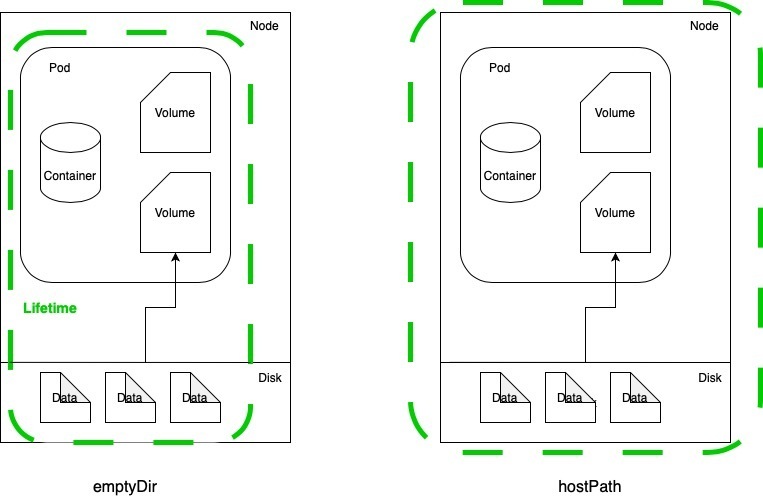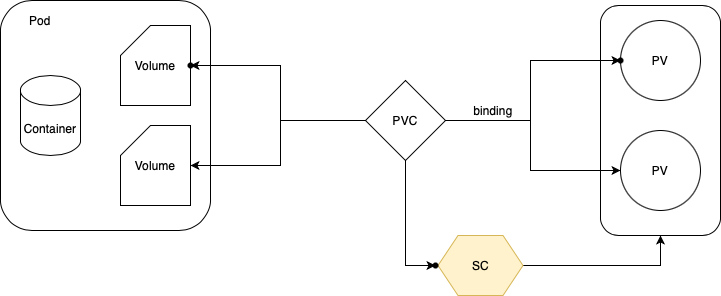3. CKA Storage
 Cheedge Lee
Cheedge LeeThe storage in cka is mainly about the way how to store the data, as the container is used for execution, which means it not include the data storage part, therefore we need the storage for no mater share data or persistent data or any related stuffs as well as the structures to connect with the real disk. First here are two concepts:
Volume: dir/filesys in Pod, where container can get data from.
Physical Store: where the data stored in the real word.

How to make this connection between volume and physical storage is the key point. In k8s we can either connect the volume with the local storage, or with external storage.
3.1 Volume Types and related Concepts
Before we talk about the workflow, here we need to give some basic concepts related to the storage, so that we can understand better for the workflow.
3.1.1 Volume Types
here we separate it into two categories,
Ephemeral volumes
Persistent volumes
"Ephemeral volume types have a lifetime of a pod, but persistent volumes exist beyond the lifetime of a pod."
3.1.1.1 Ephemeral volume
These volumes are typically tied to a single Pod or a node’s lifecycle. Here we list several commonly used types:
- emptyDir
Data: will lost when the Pod is deleted.
eg. temporary cache for web applications
- hostPath
Data: will lost when Pods are rescheduled to a different node.
eg. log files

which means the data remains on the host node after the Pod is deleted, but if the Pod is rescheduled to a different node, the data won’t be accessible unless it’s tied to the same node.
# emptyDir
apiVersion: v1
kind: Pod
...
spec:
...
volumes:
- name: cache
emptyDir: {}
# hostPath
apiVersion: v1
kind: Pod
...
spec:
containers:
...
volumes:
- name: log
hostPath:
path: /path/to/the/log
type: File
some types like configMap or secret, we will talk later in Config & Security. Other volume types can be checked here.
3.1.1.2 Persistent Volumes (PV)

- local
local disk - high performance, low-latency
node specific
- MUST have
nodeAffinityfield
- MUST have
don’t support shared access, general (RWO)
- multiple Pods CAN'T writing to the same volume across nodes
eg. a database on a specific node.
- nfs
external nfs server - slower
high availability
shared file access, ReadWriteMany (RWX)
- multiple Pods CAN read/write the same data:
eg. shared configuration data across Pods.
# local
apiVersion: v1
kind: PersistentVolume
...
spec:
capacity: # match with PVC storage field
storage: 100Gi
accessModes: # match with PVC accessModes field
- ReadWriteOnce
storageClassName: "local-storage"
local:
path: /STORE/PATH
nodeAffinity: # local MUST set nodeAffinity, as it's node specific
required:
nodeSelectorTerms:
- matchExpressions:
- key: kubernetes.io/hostname
operator: In
values:
- node01
# nfs
apiVersion: v1
kind: PersistentVolume
...
spec:
capacity: # match with PVC storage field
storage: 10Gi
accessModes: # match with PVC accessModes field
- ReadWriteMany
nfs:
path: /SHARED/PATH
server: HOST_IP
Note: here when using nfs, make sure nfs server has been installed on your computer. For Debian-based system (eg. ubuntu) install nfs-common; and for Redhat-based system (eg. CentOS) install nfs-utils.
3.1.1.3 hostPaht vs. local
Here hostPath and local seems kinda similar, but actually not.
- Similarities:
Storage Location:
- store data on the local disk of a specific node in the cluster.
No Cross-Node Sharing
- Difference:
Management:
- only local managed by k8s
Scheduling:
- as pv, k8s automatically handles node affinity
more info can check PV doc.
3.1.2 PVC
Persistent Volume Claims (PVC), simply speaking is a connection between pvs and volumes. In the document, there is an interesting analogy between pvs and Pod.
"Pods consume node resources and PVCs consume PV resources. Pods can request specific levels of resources (CPU and Memory)."
In this aspect, we can take pvs as kinda consuming request for storage resource (PV). Similarly, for Pod, we can also treat it as consuming request for calculation resources.
apiVersion: v1
kind: PersistentVolumeClaim
metadata:
name: local-pvc
spec:
accessModes: # match with PV accessModes
- ReadWriteOnce
storageClassName: local-storage # sc
resources:
requests:
storage: 50Gi # match with PV
more info refer to PVC.
3.1.3 StorageClass
StorageClass (sc), we can consider it as a "Factory Class", which dynamically provisioned PVs. Some points to remember:
if not specified, sc is default sc.
sc used for provision pv, according to pvc, via storageClassName field.(see above)

some items:
provisioner: "Production machine"
volumeBindingMode: when should we binding - when setting to WaitForFirstConsumer, until the consumer applied, this binding will be finished.
reclaimPolicy: how to recycle
allowVolumeExpansion: enlarge the volume (not shrink)
- scenario: eg. many storage objects, and make it hard to manage, then use sc will be more easy.
3.1.3.1 How PV/PVC tie with sc
# pv
apiVersion: v1
kind: PersistentVolume
...
spec:
...
storageClassName: <sc_name>
...
# pvc
apiVersion: v1
kind: PersistentVolumeClaim
...
spec:
...
storageClassName: <sc_name>
...
3.2 PV/PVC Workflow
3.2.1 yaml
# PV
apiVersion: v1
kind: PersistentVolume
...
spec:
capacity: # match with PVC storage field
storage: 10Gi
accessModes: # match with PVC accessModes field
- ReadWriteMany
nfs:
path: /SHARED/PATH
server: HOST_IP
---
# PVC
apiVersion: v1
kind: PersistentVolumeClaim
metadata:
name: local-pvc
spec:
accessModes: # match with PV accessModes
- ReadWriteOnce
storageClassName: <string> # sc name
resources:
requests:
storage: 10Gi # match with PV
---
# Pod
apiVersion: v1
kind: Pod
metadata:
name: mypod
spec:
volumes:
- name: <string> # meet with voumeMounts name below
VOL_TYPE
containers:
- name:
image:
volumeMounts:
- name: <string> # keep same as above name
mountPath: <string> # mount dir
...
3.2.1 how PV/PVC works
outdie the pod, create the PVC/PV, PV and PVC will binding according to 2 factors:
capacity:
- capacity(PV) >= storage(PVC)
access right:
ReadWriteOnce (RWO)
ReadWriteMany (RWX)
ReadOnlyMany (ROX)
inside the Pod, will create the Volume objects, and container mounts the volume.
after all preparation, Pod can use the PV for storage.

"Pods access storage by using the claim as a volume. Claims must exist in the same namespace as the Pod using the claim."
more details can refer to the document claims as volume.
3.4 CKA
3.4.1 Domains for storage in CKA exam
In official site, we can see these 4 parts for storage:
Understand storage classes, persistent volumes
Understand volume mode, access modes and reclaim policies for volumes
Understand persistent volume claims primitive
Know how to configure applications with persistent storage
It takes up 10% of cka exam.
for config, we will put it at Config & Secret.
3.4.2 Necessary Points
And let's break it down and extract some points:
Volume, volume types
Persistent View (PV)
Persistent View Claim (PVC)
Storage Class (sc)
Subscribe to my newsletter
Read articles from Cheedge Lee directly inside your inbox. Subscribe to the newsletter, and don't miss out.
Written by

Cheedge Lee
Cheedge Lee
Some blogs are from my previous blogs, even though I have renovated and checked before migration, but there may be still some parts out of date. (https://blog.sina.com.cn/u/1784323047 or https://blog.csdn.net/li_6698230?type=blog, if they're still accessible.)